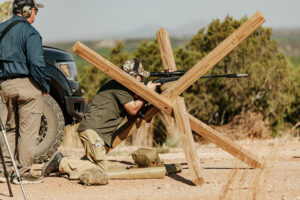Learning to shoot at long range is all the rage lately, but it can be a daunting discipline to approach. What sort of gear do you need? Where can you shoot at such incredible distances? How do different environmental conditions affect your ability to shoot? When it comes to long range shooting for beginners, there is much to be learned to be sure, but it’s no use trying to absorb it all at once. As such, read on for some tips on how to get started with long range shooting.
Tip 1: You’re Only as Good as Your Tools
Everyone in the industry seems to be selling hardware these days. The latest optic, or bullet, or rifle is apparently all the average-Joe needs to become a scout sniper. Obviously, this is a bit of an exaggeration, but the truth does lie somewhere in the middle. While you don’t necessarily need a $10k setup to shoot 1000 yards, you won’t be doing yourself any favors trying it with a duplex 3-9x40mm on top of your granddaddy’s deer rifle. As such, before you even hit the range, make sure you’ve got a rifle capable of MOA accuracy (or better), and a riflescope capable of dialing for elevation. Also ensure you have a chronograph, or some other method for measuring the speed of your projectiles, and a rangefinder. These will become important later.
Tip 2: .22 For The Wind
If you’re not capable of procuring the above, don’t despair yet. Get a decent .22 rifle and top it with the sort of riflescope just described. Shooting out to 300 yards with a .22 is a great analogue for shooting legitimate long range, and can help build many of the same skills you’ll need to do it for real. Wind calls in particular are tricky with the light little projectiles, and you can get very proficient at gauging exactly how hard the breezes are blowing.
Tip 3: Stabilize It
There are plenty of myths out there about how easy it is for some folks to shoot long range. Many get the idea they can start out shooting off a tripod, bipod, or even standing. While you will work up to these in time (that final category will always remain much more limited than the others), nothing beats the good, solid rest provided by front and rear bags–either off a bench or from the prone position. Particularly while you’re still learning elevations and wind holds, it’s best to take all other potential influences out of the equation. Once you can hit any distance, any time off bags, you can move on to the next step.
Tip 4: Don’t be Scared of Data
When first encountering the world of long-range shooting, people can be turned off by the sheer amount of calculation, measurement and mathematics involved. Unfortunately, the quickest and easiest way to improve your skills is to utilize all these modern wonders, rather than simply slinging lead until you get a hit and recording how you did it.
For starters, download a ballistic calculation app like GeoBallistics, and put in as much information about your rifle, ammunition, and environment as you possibly can. Next, chronograph your rifle’s muzzle velocity (an average of at least five works best), then input that into your app–while muzzle velocity is generally recorded on the ammo box nowadays, having an exact measurement of how it performs in your own rifle is more desirable. Finally, range your target, input that into the app, and use the elevation calculation it gives you (you’ll want to decide up front if you’re going to learn/use MOA or MRADs, to save on confusion down the road). This should get you close-to or even right-on target, and you can make adjustments from there. Once you’re hitting consistently, note how far you had to dial before moving on to the next range.
Tip 5: Take a Class
As always, there really is no replacement for expert instruction. Learning from folks who know what they’re doing will put you lightyears ahead of figuring it out on your own, and can be extremely helpful when you have specific, potentially esoteric questions that only a human can answer, as opposed to a search engine. An investment in building your skills will almost always yield a better return than investing in equipment, so while you may balk at the price tag, compare it to how much you have or will spend on rifles, quality ammo, quality glass, etc. Once you’ve decided to make that jump, check out Outdoor Solutions long range schools. We have everything needed to take you from neophyte to knowledgeable in a hurry, and show you a good time while you’re doing it.


